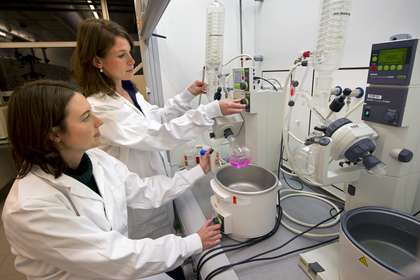Local chemotherapy has a stronger effect on reducing tumor growth

Reducing the growth of a tumor by localized delivery of cancer medication can be achieved by using a combination of ultrasound, temperature-sensitive nanoparticles and MRI. This is shown by Mariska de Smet in her PhD research at Eindhoven University of Technology (TU/e) and Philips Research. Her preclinical studies show that this local chemotherapy is more effective in reducing tumor growth than regular chemotherapy. In addition, the amount of medication reaching the tumor can be measured by adding an imaging marker to the chemo. De Smet defends her thesis on Thursday March 14th.
Using chemotherapy to treat cancer always has unpleasant side effects. The toxic effects of the medication also affect healthy cells, as well as those of the tumor itself. This leads to symptoms like nausea, hair loss or reduced effectiveness of the immune system. Scientists have been working for many years on image-guided administration of medication using 'delivery vehicles': particles that transport the medication through the body to the tumor, which can be imaged after drug release. This allows higher doses of medication to be used, while the rest of the patient's body remains unaffected.
Temperature-sensitive
TU/e and Philips Research have been carrying out research for a number of years into methods of this kind, in which temperature-sensitive liposomes (tiny fat-based spheres) act as delivery vehicles for the medication. The liposomes contain the medication and a contrast medium that is visible in an MRI scan. After injection into the blood, the liposomes transport the medication through the body. The location of the tumor is identified using MRI, after which the tumor is warmed by means of ultrasound. When the liposomes reach the tumor, the increased temperature causes them to open so that the medication and contrast medium are released.
Slowing down tumor growth
Mariska de Smet shows the effectiveness of this method in her PhD research at TU/e, in which she was supervised by prof.dr. Holger Grüll. Tumor growth was found to be reduced after treatment using this technique. In fact the effect was even stronger than with regular chemotherapy. De Smet also showed that the amount of contrast agent released was a good indicator of the extent to which tumor growth was slowed down; the more contrast medium visible, the greater the effect of the chemotherapy. Because the amount of medicine released can immediately be measured, this could enable physicians in the future to quickly decide whether to administer additional medication or to start a different form of treatment.
Clinical development
The research carried out by De Smet was of a preclinical nature. Before the therapeutic effects of the method can be investigated on patients, a number of practical obstacles still need to be overcome. De Smet expects that it will take 10 - 15 years before the new technology is available for use on patients.
More information: Mariska de Smet will gain her PhD on the 14th March at Eindhoven University of Technology for her thesis entitled 'MR-HIFU mediated local drug delivery using temperature-sensitive liposomes'.
















